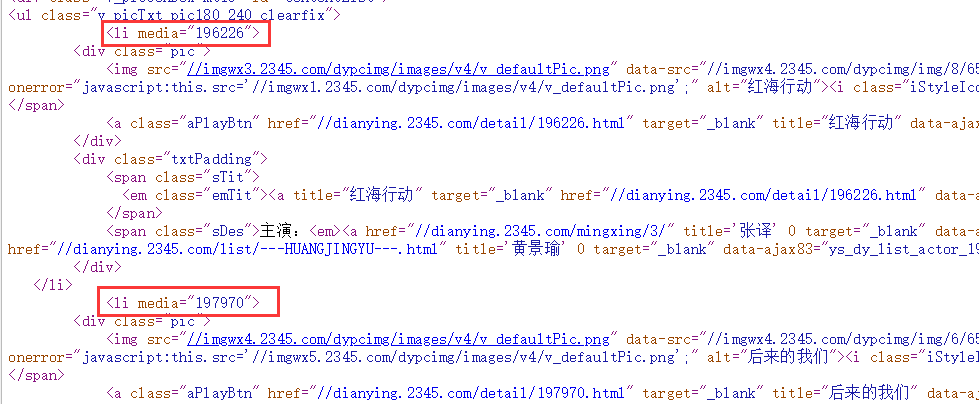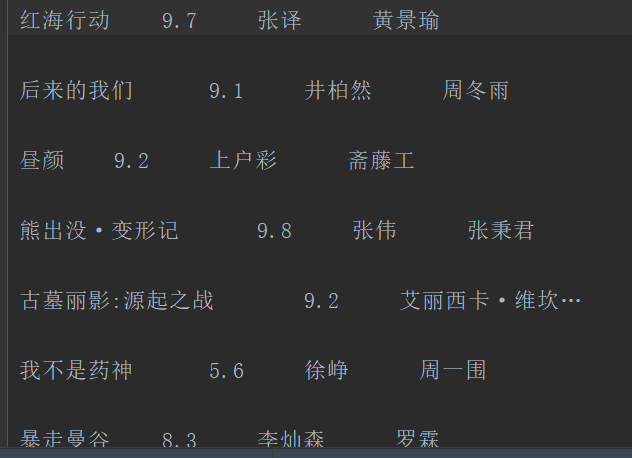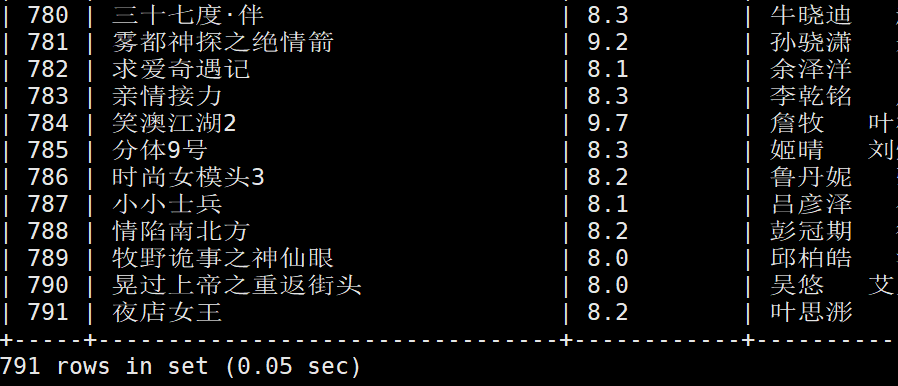bs4爬虫实战三:获取电影信息并存入mysql数据库
发布时间:2018-07-12 20:13:03编辑:Run阅读(8297)
目标分析
这次爬虫的目标网站是:http://dianying.2345.com,爬虫的搜索目标仅限于今年的电影,在网站打开搜索,在年代中选择2018

获取页面的过程
在页面的下方单击"下一页",发现URL变成了http://dianying.2345.com/list/----2018---2.html.
测试一下http://dianying.2345.com/list/----2018---1.html,可以正常返回,urls的变化规律找到了,设置一个变量,让这个变量+1,在拼接url地址,就是下一个页面的地址.
在来看看总共有多少页呢?如下图

总页数也找到了,最后只需要找到爬虫的过滤规则就可以了,单击页面空白处,在弹出菜单中选择"查看网页源代码"选项,查看页面源代码,如下图:

直接找<li>标签就可以了,先找<ul>标签,然后再嵌套查找<li>标签就行,更加精确,现在爬虫所有的要素都已准备完毕,可以构造爬虫了
项目实施
新建一个get2018movie.py的内容如下:
#!/usr/bin/env python
# coding: utf-8
from bs4 import BeautifulSoup
import urllib.request
from mylog import MyLog as mylog
from save2mysql import SaveMysql
class MovieItem(object):
moviename = None # 电影名
moviescore = None # 电影得分
moviestarring = None # 电影主演
class GetMovie(object):
def __init__(self):
self.urlBase = 'http://dianying.2345.com/list/----2018---1.html'
self.log = mylog()
self.pages = self.getpages()
self.urls = []
self.items = []
self.getUrls(self.pages)
self.spider(self.urls)
self.piplines(self.items)
self.log.info('保存到mysql中开始')
SaveMysql(self.items)
self.log.info('保存到mysql中结束')
def getpages(self):
# 获取总页数,返回一个int类型给调用者
self.log.info('开始获取页数')
htmlcontent = self.getResponseContent(self.urlBase)
soup = BeautifulSoup(htmlcontent, 'lxml')
tag = soup.find('div', attrs={'class': 'v_page'})
subTags = tag.find_all('a')
self.log.info('获取数据成功')
return int(subTags[-2].get_text())
def getResponseContent(self, url):
# 读取网页内容,并返回给调用者
fakeHeaders = {'User-Agent': 'Mozilla/5.0 (Windows NT 10.0; WOW64) AppleWebKit/537.36 (KHTML, like
Gecko) Chrome/67.0.3396.62 Safari/537.36'}
request = urllib.request.Request(url, headers=fakeHeaders)
try:
response = urllib.request.urlopen(request)
html = response.read().decode('gbk')
except Exception as e:
self.log.error('Python 返回URL:{} 数据失败'.format(url))
else:
self.log.info('Python 返回URL:{} 数据成功'.format(url))
return html
def getUrls(self, pages):
# 找到所有下一页的url地址,返回一个urls列表
urlHead = 'http://dianying.2345.com/list/----2018---'
urlEnd = '.html'
for i in range(1, pages+1):
url = urlHead + str(i) + urlEnd
self.urls.append(url)
self.log.info('添加URL:{}到URLS列表'.format(url))
def spider(self, urls):
# 过滤信息
for url in urls:
htmlcontent = self.getResponseContent(url)
soup = BeautifulSoup(htmlcontent, 'lxml')
anchorTag = soup.find('ul', attrs={'class': 'v_picTxt pic180_240 clearfix'})
# 爬取的时候,发现有个反爬机制,需要排除掉,不然程序爬到那里会报错
# 找到广告这个li标签
fanpa = anchorTag.find('li', attrs={'class': 'item-gg'})
tags = anchorTag.find_all('li')
if fanpa in tags: # 判断广告在不在需要爬取的列表
tags.remove(fanpa) # 移除掉广告
for tag in tags:
item = MovieItem()
item.moviename = tag.find('span', attrs={'class': 'sTit'}).get_text().strip()
item.moviescore = tag.find('span', attrs={'class':'pRightBottom'}).em.get_text().
strip().replace('分', '')
item.moviestarring = tag.find('span', attrs={'class': 'sDes'}).get_text().strip().
replace('主演:', '')
self.items.append(item)
self.log.info('获取电影名为:《{}》成功'.format(item.moviename))
def piplines(self, items):
# 数据处理
filename = '2018热门电影.txt'
with open(filename, 'w', encoding='utf-8') as f:
for item in items:
f.write("{}\t\t{}\t\t{}\r\n".format(item.moviename, item.moviescore, item.moviestarring))
self.log.info('电影名为:《{}》已成功存入文件{}...'.format(item.moviename, filename))
if __name__ == '__main__':
GM = GetMovie()mylog.py代码:
#!/usr/bin/env python
# coding: utf-8
import logging
import getpass
import sys
# 定义MyLog类
class MyLog(object):
def __init__(self):
self.user = getpass.getuser() # 获取用户
self.logger = logging.getLogger(self.user)
self.logger.setLevel(logging.DEBUG)
# 日志文件名
self.logfile = sys.argv[0][0:-3] + '.log' # 动态获取调用文件的名字
self.formatter = logging.Formatter('%(asctime)-12s %(levelname)-8s %(message)-12s\r\n')
# 日志显示到屏幕上并输出到日志文件内
self.logHand = logging.FileHandler(self.logfile, encoding='utf-8')
self.logHand.setFormatter(self.formatter)
self.logHand.setLevel(logging.DEBUG)
self.logHandSt = logging.StreamHandler()
self.logHandSt.setFormatter(self.formatter)
self.logHandSt.setLevel(logging.DEBUG)
self.logger.addHandler(self.logHand)
self.logger.addHandler(self.logHandSt)
# 日志的5个级别对应以下的5个函数
def debug(self, msg):
self.logger.debug(msg)
def info(self, msg):
self.logger.info(msg)
def warn(self, msg):
self.logger.warn(msg)
def error(self, msg):
self.logger.error(msg)
def critical(self, msg):
self.logger.critical(msg)
if __name__ == '__main__':
mylog = MyLog()
mylog.debug(u"I'm debug 中文测试")
mylog.info(u"I'm info 中文测试")
mylog.warn(u"I'm warn 中文测试")
mylog.error(u"I'm error 中文测试")
mylog.critical(u"I'm critical 中文测试")如果想要存入mysql数据库,需要先把数据库,表和表结构创建好,还需要知道库名,ip地址,端口,账号和密码
mysql上面的操作,准备工作
mysql> create database bs4DB; Query OK, 1 row affected (0.06 sec) mysql> use bs4DB; Database changed mysql> create table this_year_movie(id int auto_increment,moviename char(30),moviescore char(10),moviestarri ng char(40), PRIMARY KEY(id)) ENGINE=InnoDB DEFAULT CHARSET=utf8; Query OK, 0 rows affected (0.61 sec) mysql> desc this_year_movie; +---------------+----------+------+-----+---------+----------------+ | Field | Type | Null | Key | Default | Extra | +---------------+----------+------+-----+---------+----------------+ | id | int(11) | NO | PRI | NULL | auto_increment | | moviename | char(30) | YES | | NULL | | | moviescore | char(10) | YES | | NULL | | | moviestarring | char(40) | YES | | NULL | | +---------------+----------+------+-----+---------+----------------+ 4 rows in set (0.00 sec) mysql> use mysql; Reading table information for completion of table and column names You can turn off this feature to get a quicker startup with -A Database changed mysql> create user 'savemysql'@'%' identified by 'savemysql123'; #创建mysql连接账号密码 Query OK, 0 rows affected (0.12 sec) mysql> grant all privileges on bs4DB.* to "savemysql"@'%'; # 授权savemysql只能操作bs4DB数据库 Query OK, 0 rows affected (0.00 sec) mysql> flush privileges; Query OK, 0 rows affected (0.07 sec)
如果没有安装pymysql,先pip3 install pymysql
新建一个save2mysql.py文件
#!/usr/bin/env python
# coding: utf-8
import pymysql
class SaveMysql(object):
def __init__(self, items):
self.host = '192.168.11.88' # mysql服务器ip地址
self.port = 3306 # mysql服务端的端口
self.user = 'savemysql' # mysql服务器用户名
self.passwd = 'savemysql123' # mysql服务器密码
self.db = 'bs4DB' # 使用的库名
self.run(items)
def run(self, items):
conn = pymysql.connect(host=self.host,
user=self.user,
password=self.passwd,
port=self.port,
database=self.db,
charset='utf8',
)
cur = conn.cursor()
for item in items:
cur.execute("insert into this_year_movie(moviename, moviescore, moviestarring) \
values (%s, %s, %s)", (item.moviename, item.moviescore, item.moviestarring))
cur.close()
conn.commit()
conn.close()
if __name__ == '__main__':
pass运行程序:

2018热门电影.text截图

登陆到mysql查看一下数据是否成功插入
mysql> use bs4DB; Reading table information for completion of table and column names You can turn off this feature to get a quicker startup with -A Database changed mysql> show tables; +-----------------+ | Tables_in_bs4DB | +-----------------+ | this_year_movie | +-----------------+ 1 row in set (0.00 sec) mysql> select * from this_year_movie;
查询结果:

- openvpn linux客户端使用
51833
- H3C基本命令大全
51559
- openvpn windows客户端使用
41921
- H3C IRF原理及 配置
38729
- Python exit()函数
33215
- openvpn mac客户端使用
30202
- python全系列官方中文文档
28857
- python 获取网卡实时流量
23863
- 1.常用turtle功能函数
23781
- python 获取Linux和Windows硬件信息
22144
- Ubuntu本地部署dots.ocr
245°
- Python搭建一个RAG系统(分片/检索/召回/重排序/生成)
2427°
- Browser-use:智能浏览器自动化(Web-Agent)
3095°
- 使用 LangChain 实现本地 Agent
2577°
- 使用 LangChain 构建本地 RAG 应用
2537°
- 使用LLaMA-Factory微调大模型的function calling能力
3244°
- 复现一个简单Agent系统
2533°
- LLaMA Factory-Lora微调实现声控语音多轮问答对话-1
3355°
- LLaMA Factory微调后的模型合并导出和部署-4
5534°
- LLaMA Factory微调模型的各种参数怎么设置-3
5333°
- 姓名:Run
- 职业:谜
- 邮箱:383697894@qq.com
- 定位:上海 · 松江
